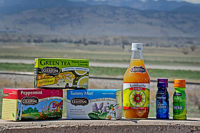Like companies across all categories within the beverage industry, players in the tea category are fighting for consumers’ attention. This competition becomes
| Jump to: |
even more challenging when you consider the various consumer demographics, preferences and needs as well as consumption occasions throughout the year. To address these challenges and capitalize on its established tea portfolio, Celestial Seasonings is focused on expanding its core products and creating new ones all while staying true to its roots.
A brand of The Hain Celestial Group operating out of Boulder, Colo., Celestial Seasonings was founded by a group of entrepreneurs in 1969. It began with loose, herbal teas, but today the company has expanded its offerings to include multiple bagged teas — including herbal, wellness, green, rooibos, chai, holiday and iced teas — as well as ready-to-drink (RTD) kombucha drinks, natural shots and K-Cup packs for Waterbury, Vt.-based Green Mountain Coffee Roasters Inc.’s (GMCR) Keurig brewing system.
The company’s Sleepytime brand, which blends chamomile, spearmint, lemongrass and other herbs and botanicals, has remained its No. 1-selling product since the late 1970s, says Peter Burns, president of Celestial Seasonings and chief sales officer of Hain Celestial US.
“Sleepytime is how most folks identify with Celestial Seasonings,” he says. Plus, consumers have an emotional connection with the brand, he adds.
“If you think about our consumer — our consumer skews female 35 and up — and when we talk to folks in focus groups, they will explain to us their emotional connection with the Sleepytime business,” Burns says. “So if it’s a mom, the kids are in bed, and it’s her time to enjoy a cup of tea in the winter time. They talk about how they put their hands around the mug and they cradle it and enjoy it and smell it, so it’s a very experiential brand and business.”
Building on the product’s equity, the Sleepytime brand now extends across all of the company’s major segments of tea, including its green teas, wellness teas and flavored herbal teas. The Sleepytime franchise alone accounts for nearly 6 percent of the total share of specialty tea, says Jennifer Stolte, senior director of marketing. Last year, original Sleepytime tea sales increased approximately 10 percent, she adds.
“When we extend it to [flavors] like vanilla and peach and then we bring it into the green [tea] family and then into the wellness family, it’s a natural extension of developing the Sleepytime franchise,” Burns says. “Our Sleepytime business this hot tea season is up almost
30 percent.” Hot tea season operates from October through March, the company notes.
This month, the brand launched Sleepytime Decaf Blackberry Pomegranate Green Tea in response to the success of its Sleepytime Decaf Lemon Jasmine Green Tea, Stolte says.
“Sleepytime Decaf Green Tea was satisfying a need state that was missing for consumers,” she explains. “A lot of consumers drink their green tea in the morning, they drink it in the afternoon, but because of the caffeine they don’t drink it at night. This was a great opportunity for a need state in the evening that wasn’t being addressed by green [tea], so we were able to fill that and we’re seeing great success with this.”
The company also launched Sleepytime Kids last year to reach a younger demographic. Research discovered that parents were already giving their children Sleepytime tea, so the company developed Sleepytime Kids, which features a Grape flavor and is sweetened with stevia to better suit the taste profiles of children. The tea also is fortified with vitamin C, Stolte notes.
Take your best shot
Late last year, the Sleepytime brand expanded its reach even further, entering the sleep aid segment with Sleepytime Snooz Natural Sleep Aid herbal supplement
“We started to see that there was this growing trend in shots … and felt that we could really get out there with the Sleepytime name and really drive that category,” Stolte says. |
shots. This represents the third line of natural shots under the Celestial Seasonings brand name, preceded by Kombucha Energy Shots and ENERJI Green Tea Energy Shots.
“We started to see that there was this growing trend in shots … and felt that we could really get out there with the Sleepytime name and really drive that category,” Stolte says. “Almost three-quarters of the population have issues sleeping, so that’s a pretty big piece, and there’s a lot of people out there that are looking for natural alternatives, so we figured that was a great opportunity.”
Furthermore, the brand experienced success with its ENERJI Green Tea Energy Shots, which launched in the fall of 2012, so the team was further encouraged to launch a natural sleep aid shot, she adds. However, unlike Sleepytime teas, Sleepytime Snooz Natural Sleep Aid shots were formulated to help consumers fall asleep faster, stay asleep longer and wake up refreshed without grogginess, Stolte notes. The shots contain a proprietary blend of ingredients such as valerian, melatonin, l-theanine, chamomile and jujube.
With the opposite effect, Enerji Green Tea Energy Shots contain 100 mg of caffeine from green tea, B vitamins and ginseng, Stolte says. The line also includes a Pomegranate Extreme variety with 150 mg of caffeine, she notes.
The company’s first foray into natural shots, however, was its Kombucha Energy Shots, which were inspired by its RTD kombucha line.
“Our whole thought is the energy business is a very strong business right now, but it’s dominated by folks who don’t believe in all-natural, good-for-you ingredients,” Burns says. “We believe if we can offer the benefits of all-natural energy, whether it be in a kombucha base or green tea energy base, that we can get consumers who want the benefits of energy products but don’t want all the bad stuff associated with those.”
Kombucha, a fermented black tea that contains naturally occurring enzymes, probiotic cultures and beneficial acids, often is consumed for its energy properties, according to research conducted by Celestial Seasonings. Therefore, the company supplemented the authentic, live, raw kombucha — which it produces, ferments and grows at its own facility — in its Kombucha Energy Shots with a proprietary blend of energizing ingredients to boost its function, Stolte says.
“What we did is, in our Kombucha line and then extending into our shots line, we took some of the basic benefits of kombucha — one of them being energy — and then added some additional energy ingredients,” she explains. “So in our Kombucha Energy Shots, we’ve added B vitamins and ginseng plus caffeine from guarana to give it that extra lift. So [consumers are] getting some lift from the kombucha and then an additional lift from the functional ingredients that we’ve added.”
Its RTD Kombucha line also includes an Energy variety, which contains B vitamins and ginseng for a functional benefit. The rest of the line is made up of an Original variety as well as the following functional SKUs: Digestion, which contains prebiotics and ginger to support digestive health; Antioxidant, which contains vitamin C to support immunity and well-being; Metabolism, which contains green tea extract and B vitamins to support a healthy metabolism; and Super Green, which contains spirulina for concentrated green food nutrients.
The 16-ounce RTD Kombucha line has been available in limited distribution in the Southwest region since its launch but recently expanded nationwide.
“Where we have distribution, we have very solid velocity numbers, so that business, although it is small right now, is growing very quickly,” Stolte says.
Drink to your health
One of the brand’s core businesses is its wellness line of teas, which provides functional benefits for everyday or seasonal consumer use.
People are looking for natural alternatives or supplements, Stolte says. “They’re looking for products that might settle their stomach, they’re looking for products that might help with metabolism, and you’re starting to see on store shelves this proliferation of natural alternatives that people can try and use,” she explains. “I think for us, being the leaders in specialty tea, a lot of our teas … that fell into our original herbal line … people always used for that wellness piece. For us, it was this natural movement into the wellness segment and taking some of the herbs that we know so well and taking the benefits of those and really making products that are condition-specific that consumers are looking for.”
Celestial Seasonings’ wellness lineup consists of three different Antioxidant Max Green Teas as well as LaxaTea, Metabo Balance, Natural Detox, Tummy Mint, Sleepytime Sinus Soother, Sleepytime Throat Tamer, Sleepytime Echinacea Complete Care and Sleepytime Extra, which is the brand’s best-selling wellness tea, Stolte says. Wellness is the fastest-growing segment in the specialty tea category, and it is the largest segment in the natural foods channel, she notes.
Best sellers
However, the brand’s herbal teas remain at the core of its business.
“Herb is definitely the heart of where Celestial Seasonings started and still continues to be a big mainstay for the Celestial Seasonings brand,” Stolte says.
The brand offers approximately 30 different herbal teas, including several Sleepytime varieties, Zinger teas and more. Zinger teas all contain hibiscus, which gives the tea a red color. Last year, the company also launched Jammin’ Lemon Ginger herbal tea, which is performing extremely well, Stolte says. Other top-selling herbal teas include Chamomile, Peppermint and its Fruit Tea Sampler, which contains five of the brand’s most popular fruit-flavored teas, she notes.
Second to its herbal teas are its green teas, which typically are consumed for their health benefits, whereas consumers who purchase herbal teas often are looking for variety, Stolte says. Like green tea, rooibos tea naturally contains flavonoid antioxidants. Although rooibos teas are still emerging in the U.S. market, Celestial Seasonings’ rooibos teas have a fair market and are gaining ground each year, says Charlie Baden, senior blendmaster.
In the natural channel, one of the brand’s top-selling teas is Bengal Spice, which is basically a caffeine-free chai tea, Stolte says. Its actual chai tea portfolio consists of four varieties, two of which are decaf. Distribution for its chai teas is limited; however, where the teas are distributed, they perform well, she says. In fact, the teas currently are growing in the double digits, she adds.
For consumers looking for a cold tea drink, the brand offers two lines of iced teas: Sweet Zinger Ice and Cool Brew. Sweet Zinger Ice flavored herbal teas feature hibiscus like the rest of Celestial Seasonings’ Zinger teas but are naturally sweetened with stevia. Instead of brewing in hot water, Cool Brew flavored iced teas brew in cold water for five minutes.
Celestial Seasonings also expanded the holiday tea drinking occasion by launching its newest seasonal flavor in at least a decade, Stolte says. Sweet Harvest Pumpkin combines black tea with real pumpkin flavor and a hint of sweetness, the company says.
“The nice thing about that item is that it opened up a little bit more of a season for holiday tea,” Stolte says. “Normally, our holiday teas are positioned around the Christmas holiday with our Candy Cane Lane, Gingerbread Spice, Nutcracker Sweet, [Sugar Cookie Sleigh Ride and Sugar Plum Spice], but Sweet Harvest Pumpkin really allowed us to open up that fall season all the way through the holiday season, and it’s a great-tasting flavor.”
By offering a wide variety of tea-based products, Celestial Seasonings is able to appeal to a number of different consumers throughout the entire year.
“Our average consumer has anywhere between six and eight boxes of tea in their cupboard,” Burns says. “It’s becoming less seasonal, and we’re doing things and introducing products that help expand the franchise.”
Good things come in small packages
Celestial Seasonings also is providing its consumers with options outside the bag. To celebrate its Sleepytime brand’s 40th anniversary last year, it introduced vintage boxes for the product. Throughout its history, the brand has been committed to distinctive packaging that tells a story. All of its products feature commissioned artwork and thoughtful quotes that help the brand to stand out from the rest. For instance, boxes of Sleepytime Kids showcase Sleepytime Bear reading a book to his two cubs by the fireplace.
“We go through a lengthy process with our creative team to make sure we find the right artist and create the right story that we’re telling on that box, so as you look across all of our items, you can see the story being told, and that’s really important to us, and our consumers recognize that,” Stolte explains. “We’ll be in focus groups and they’ll say, ‘Oh, I buy that one. It’s the one with the buffalo on the box.’ And that artwork, the quotes on the box, and all of that really is part of that whole Celestial Seasonings story.”
Additionally, all of the tea boxes are made of recycled paperboard, including 35 percent post-consumer waste, and the tea bags are biodegradable and compostable, according to the brand.
Some of the brand’s teas also are available in K-Cup packs to be used with GMCR’s Keurig brewing system. Approximately 20 Celestial Seasonings hot teas are available in K-Cup packs, Stolte says. On the iced tea side, Celestial Seasonings worked with GMCR to develop a line of teas exclusively in K-Cup packs. The line includes Southern Sweet Black Tea, Half and Half Black Tea and Lemonade, Sweet Raspberry Black Tea, Sweet Peach Black Tea, Sweet Lemon Black Tea and Unsweetened Black Tea.
“Green Mountain has really put an effort into growing distribution on K-Cup packs over the past few years, and we have seen significant growth,” she says. “We saw triple-digit dollar sales growth in Nielsen-measured channels over the last 52 weeks.”
In the future, Celestial Seasonings will continue to work with GMCR to put its teas in K-Cups. Additionally, the brand will likely experiment with additional holiday teas, Sleepytime expansions, black teas, RTD offerings and natural shots, Burns says.
Consumers are becoming increasingly interested in healthier alternatives, which is in the brand’s favor, he says. However, the brand always will be challenged to keep its portfolio fresh, innovative and on top of the trends, he adds.
“When you’re in the lead and you’re in that leadership position, if you’re not innovating, reinventing yourself, coming up with new things, new ideas, keeping it fresh, you’re going to lose that position, so that’s probably our biggest challenge,” Burns says.
“It comes back to listening to your consumer and over-delivering their experience with tea,” he says. “Taste, packaging, sourcing, promotion, whatever it is, you just have to over-deliver for the consumer to keep them. I think we do that year on year.”
Stolte adds that it’s also important to stay true to the brand’s original mission. “It’s about products that are good for you and good for the world and making sure that everything that we launch as an extension outside of tea fits into that and makes sense for the brand,” she says.










